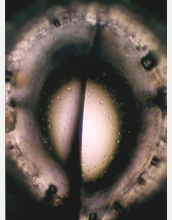Multimedia Gallery
Hollow iridium wire
A tiny, hollow iridium wire used as a reaction vessel for materials research. The wire is only 1 millimeter in diameter, the hollow just over half a millimeter. Inside is yttrium aluminum garnet (YAG), a material important for laser devices. It can be melted and supercooled to a tiny glassy drop that reveals what scientists call density-driven phase separation--the same molten material solidifies in two ways. Small blobs scattered throughout the sample are not as dense as the matrix. The vertical line seen in the picture is a crack that formed during cooling.
Paul McMillan and colleagues at Arizona State University's Materials Research Group are researching new chemistry processes that involve the use of immense amounts of pressure to compress materials and alter their molecular structure. These processes are similar to what occurs to rocks and minerals deep within the Earth and other planets. The group focuses on chemical compositions that may provide new types of materials that could be used in emerging technologies. McMillan is trying to develop a new way of carrying out chemistry. Most processes for making new materials use temperatures and chemical composition as the variables. The use of pressure is virtually unknown.
McMillan's research is supported by a grant from the National Science Foundation's Division of Materials Research.
Credit: Arizona State University
Images and other media in the National Science Foundation Multimedia Gallery are available for use in print and electronic material by NSF employees, members of the media, university staff, teachers and the general public. All media in the gallery are intended for personal, educational and nonprofit/non-commercial use only.
Images credited to the National Science Foundation, a federal agency, are in the public domain. The images were created by employees of the United States Government as part of their official duties or prepared by contractors as "works for hire" for NSF. You may freely use NSF-credited images and, at your discretion, credit NSF with a "Courtesy: National Science Foundation" notation.
Additional information about general usage can be found in Conditions.
Also Available:
Download the high-resolution TIFF version of the image. (5 MB)
Use your mouse to right-click (Mac users may need to Ctrl-click) the link above and choose the option that will save the file or target to your computer.



